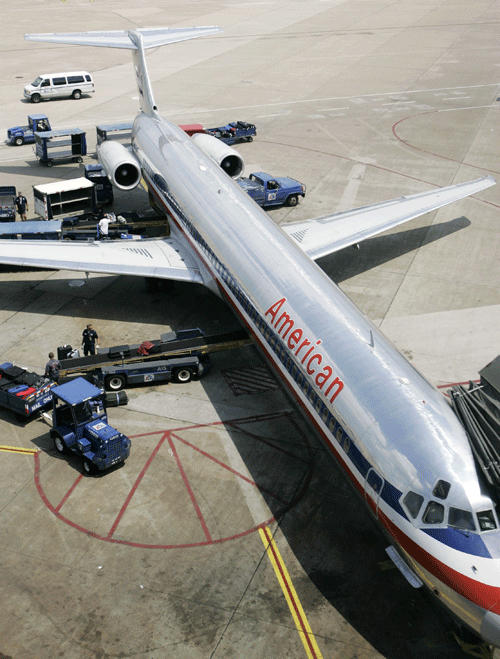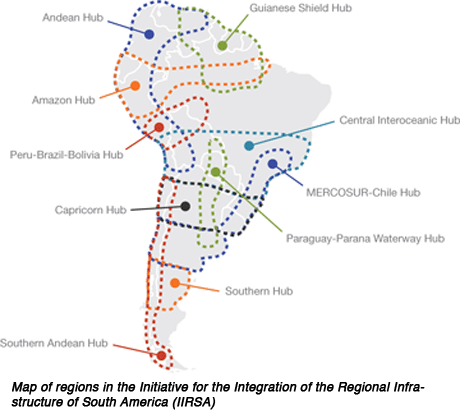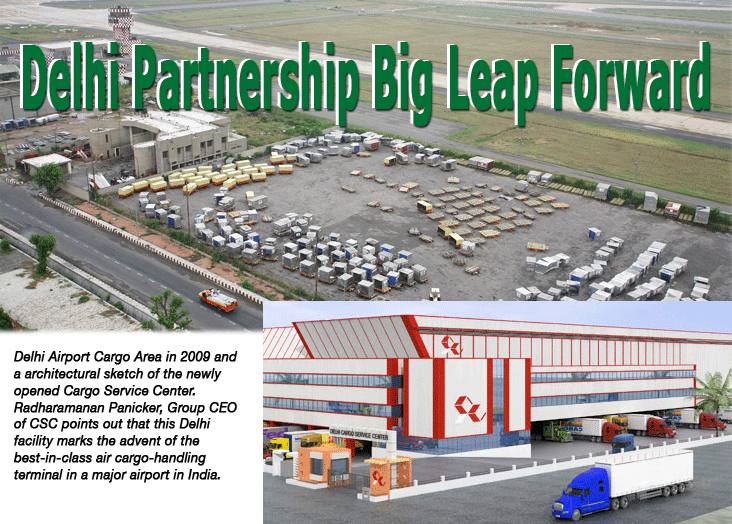| 
Intermodal
Latin America concluded on April 12 in Sao Paulo, and was
once again one of the important transportation shows that
nobody seems to know much about.
By that we mean that much
ink (if anybody is printing anymore) and even more attention
is paid to trade shows in other places that, in truth, are
not as well attended by the diverse and important group
of transportation professionals present at Intermodal.
Something to think about for
next April 2013.
Here we offer an excellent
overview of the South American market from American Airlines
Business Insights.
Despite everything else going
on at that great legacy flag carrier, American Cargo continues
to be the standard of U.S. belly lift airlines and gets
a lot of credit for genuine, helpful outreach beyond just
the hard sell and the basic information of an air cargo
website.
 For
much of the 20th century, Latin American economies showed
little growth and weak demand, particularly when compared
against other booming global markets. For
much of the 20th century, Latin American economies showed
little growth and weak demand, particularly when compared
against other booming global markets.
In recent years, however,
changing economic policies, globalization, energy discoveries,
and myriad other factors have given rise to budding economies
boasting robust exports and wealthier middle classes.
During the most recent global
financial crisis, many Latin American markets weathered
the economic storm better than other regions in the world.
While the International Monetary Fund lowered its 2011 economic
growth forecast for Latin America, citing slower demand
given tighter macroeconomic policies and weaker global growth,
Latin America and Caribbean economies, driven by commodity
producers, should expand 4.5 percent this year.
Brazil—one of the famed
BRIC countries—has the sixth largest economy in the
world, with a GDP of more than $2.2 trillion, but other
Latin America countries are also showing growing demand
and exports. By this, Latin America is one of the most promising
regions for air cargo.
The top five trends driving
growth and opportunity in Latin America.
Trend One: Political Stability
Political stability in Latin
America is growing. Many people in the region live under
an elected, civilian government, which encourages foreign
investment and fosters economic growth. Colombia, Chile,
and Peru enjoy relatively stable democracies favoring foreign
capital and investment. In 2011, Standard & Poor’s
upgraded Argentina’s credit rating to a “B”
and classified the country as “stable.” And
the economic powerhouse, Brazil, which also has a stable
political environment, has one of the fastest growing markets
in the world, poised to grow stronger with the World Cup
in 2014 and the Olympic Games in 2016.
Not all Latin American countries
have found the same level of political stability. Bolivia,
Ecuador, and Venezuela can be unstable, with problems found
in absent infrastructure and poor rule of the law. Yet,
the overall trend for the region is one of increasing stability
and opening markets. The kind of statist, populist solutions
that probably cost Latin America decades of economic growth
in the 20th century are viewed today largely with suspicion,
even in the countries where they still hold sway.
In many places, things that once
held business back, such as monetary instability and shortages
of even the most basic items, are becoming things of the
past.
Trend Two: Economic Institutions Strengthening
Trade and investment regimes have
been liberalized, foreign direct investment has increased,
and new export markets have come on stream. The region now
attracts around 7 percent of global foreign direct investment
and accounts for 6 percent of global exports. These positive
signs are evidence that the region’s economic institutions
are growing stronger.
Collaborative efforts such as the
Latin American Reserve Fund (FLAR), consisting of Bolivia,
Colombia, Costa Rica, Ecuador, Peru, Uruguay, and Venezuela,
offer loans or loan guarantees, improve investment conditions
in international reserves, and help harmonize exchange rates
and monetary and financial policies of member countries.
There has also been growth in banking throughout Latin America,
driven by a growing middle class, growth in deposits and
credit, and greater banking efficiency.
Brazilian banks lead the pack,
holding the top five spots on The Banker’s list of
best Latin American banks. Colombian and Peruvian capital
markets are developing quickly and (relatively) mature markets,
such as Chile, continue to have high growth rates. Yet,
persistent inflation in Brazil (which reached a seven-year
high of 6.5 percent in 2011, but has eased in the first
months of 2012) is limiting tax incentives and stimulus
measures for industries struggling through the global economic
downturn, leading economic officials to project only about
3 percent growth for the next few years.
Furthermore, while Latin American
and Caribbean banking systems are strengthening, the IMF
emphasizes the importance of monitoring financial sector
vulnerabilities and strengthening financial sector supervision
to contain excessive leverage and avoid boom-bust credit
cycles. An IMF report said capital controls could provide
temporary relief to strong portfolio investment inflows
into commodity-exporting countries.
Trend Three: Growth
of the Middle Class
Latin American countries hold rapidly
growing middle classes, driven in part by the commodities
boom in the last decade. With 56 million households joining
the middle class over the last decade, totaling 51 percent
of the major Latin American economies in 2011 (up from 41
percent in 2001) consumers enjoy greater buying power and
discretionary spending. This is creating a demand for goods
and industries that rely on air cargo to move their products
throughout the world.
Part of the growth in the middle
classes can be attributed to demographics—the working
age population is now greater than the population of those
not able to work, offering families increased income. Access
to consumer credit is also fueling a new consumerism, driving
demand for technology and myriad consumer products at levels
never before seen in the region. The strengthening financial
institutions support this. With Latin American banks focusing
on products for the consumer market and lending strategies
for the retail segment, emerging middle classes now show
a greater demand for consumer goods—and the means
to pay for it.
 Trend
Four: Intra-regional Development Trend
Four: Intra-regional Development
Since 1959, the Inter-American
Development Bank (IDB) has been the largest source of development
financing for Latin America and the Caribbean. While the
bank is owned by 48 states (including some European nations
and the United States), only 26 countries are able to receive
loans, all of which are in Latin America. Tariffs in the
region have fallen from 40 percent in the 1980s to only
10 percent in 2008. Progress in trade facilitation measures
has been slow, due in part to not enough funding opportunities
and political deadlocks. Nevertheless, with a market of
over 550 million people, most of who speak two closely related
languages and share a common cultural history, free-trade
agreements through regional trade unions like MERCOSUR and
CAFTA are making an impact.
One challenge in fostering intra-regional
development is infrastructure spending, which lags behind
other middle-income countries such as China. The absence
of updated infrastructure hinders productivity and competitiveness
of Latin American companies, which slows economic growth
overall. A World Bank Economist on Latin America and the
Caribbean infrastructure said the region “has now
fallen behind for electricity, roads, and fixed telephone
lines, with only cellular telephony and access to safe water
and sanitation facilities performing comparatively well.”
This, however, could change in
the coming years given the Initiative for the Integration
of the Regional Infrastructure of South America (IIRSA),
first launched in 2000. The IIRSA, backed by the Corporación
Andina de Fomento, the River Plate Basin Financial Development
Fund (Fonplata), and the IDB, is a plan to join Latin American
economies via transportation, energy, and telecommunications
infrastructure development. Integrating regional infrastructure
will foster trade and more closely link Latin American countries.
Trend Five: Globalization and International Trade Policies
No longer mired in economic stagnation,
Latin America has strengthened its connections with the
global economy. Several countries also have free-trade agreements
with the United States and European Union, giving them more
access to hundreds of millions of potential customers. Growth
in China in particular is opening new markets. In 2009,
China replaced the United States as Brazil’s largest
trading partner, and while a recent downgrade in China’s
expected growth has upset some markets in Latin America,
the trend of greater interaction with international markets
is boosting Latin American exports and its economies.
In October 2011, President Obama
signed Free Trade Agreements (FTAs) with Panama, Colombia
and South Korea. The Latin American agreements will stimulate
economic growth in the region, as well as in the United
States. The Colombia and Panama FTAs create a nearly uninterrupted
free trade zone from Canada to Chile. From a cargo perspective,
opening doors and facilitating trade in a wide variety of
countries is a good thing for forwarders, carriers and their
operations. As an example, between 1985 and 2008, for countries
with which the United States holds FTAs, trade grew on average
25.6 percent in the first three years after the FTA was
signed.
How American Can
Help
American has serviced customers
in nearly every country in Latin America for almost 25 years.
Yet, we see this as just the beginning. These economies
are growing fast and poised to grow stronger. The new FTAs
mean more trade is on the way, and for shippers, forwarders
and carriers, this is an opportunity to reach new markets
and develop new business.
While new economic realities and
the FTAs make international commerce much easier and more
lucrative, operating in Latin America requires expertise
in working with customs agencies and understanding the culture
of commerce and regulation. This is gained through decades
of experience, and it is critical to prosperity in these
growing markets. Partnerships between shippers and logistics
providers will advance new opportunities and help navigate
the pitfalls in this developing region. |







 The Greenfield Cargo
Terminal’s first customer was Hercules Aviation, which
approached DCSC to move 150 MT of shipment headed to Kabul.
With three freighters spread out over three days, CSC’s
warehouse staff and management handled the shipments efficiently
enough to receive a pat on the back. Commented Sujeen Paulose,
(left) Director-Commercial, Hercules Aviation, “Hercules
Aviations has used DCSC Terminal and is proud to give the
first loads. DCSC and Hercules will be remembered in history
for being partners. The service provided was first class
and we are satisfied with the work and quality of staff.
We hope the same endeavor will remain.”
The Greenfield Cargo
Terminal’s first customer was Hercules Aviation, which
approached DCSC to move 150 MT of shipment headed to Kabul.
With three freighters spread out over three days, CSC’s
warehouse staff and management handled the shipments efficiently
enough to receive a pat on the back. Commented Sujeen Paulose,
(left) Director-Commercial, Hercules Aviation, “Hercules
Aviations has used DCSC Terminal and is proud to give the
first loads. DCSC and Hercules will be remembered in history
for being partners. The service provided was first class
and we are satisfied with the work and quality of staff.
We hope the same endeavor will remain.” For
Radharamanan Panicker, (right) Group CEO, it was another
pat on the back that DCSC was doing things right. Sitting
in his office on the top floor of the terminal building,
Panicker pointed out that the Delhi facility marked the
advent of the best-in-class air cargo-handling terminal
in a major airport in India.
For
Radharamanan Panicker, (right) Group CEO, it was another
pat on the back that DCSC was doing things right. Sitting
in his office on the top floor of the terminal building,
Panicker pointed out that the Delhi facility marked the
advent of the best-in-class air cargo-handling terminal
in a major airport in India.  “Delhi and North
India,” said Tushar Jani, (left) Chairman, Cargo Service
Center, “is a very strategic area for the logistics
industry and for the country's economy. This area has tremendous
potential owing to its huge capacity of disposable income.”
“Delhi and North
India,” said Tushar Jani, (left) Chairman, Cargo Service
Center, “is a very strategic area for the logistics
industry and for the country's economy. This area has tremendous
potential owing to its huge capacity of disposable income.”
 For
much of the 20th century, Latin American economies showed
little growth and weak demand, particularly when compared
against other booming global markets.
For
much of the 20th century, Latin American economies showed
little growth and weak demand, particularly when compared
against other booming global markets.  Trend
Four: Intra-regional Development
Trend
Four: Intra-regional Development




